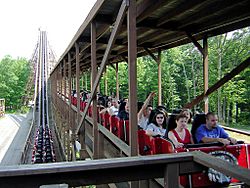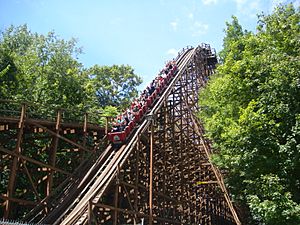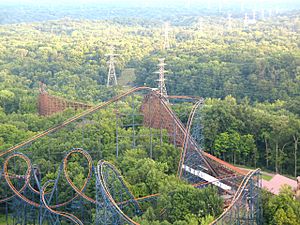The Beast (roller coaster) facts for kids
Quick facts for kids The Beast |
|
|---|---|

The Beast's lift hill and brake run
|
|
| Kings Island | |
| Location | Kings Island |
| Park section | Rivertown |
| Coordinates | 39°20′25″N 84°15′58″W / 39.3402°N 84.2660°W |
| Status | Operating |
| Soft opening date | April 13, 1979 |
| Opening date | April 14, 1979 |
| Cost | $3.2 million |
| General statistics | |
| Type | Wood |
| Manufacturer | Kings Island |
| Designer | Al Collins Jeff Gramke |
| Track layout | Terrain |
| Lift/launch system | 2 Chain lift hills |
| Height | 110 ft (34 m) |
| Drop | 141 ft (43 m) |
| Length | 7,359 ft (2,243 m) |
| Speed | 64.78 mph (104.25 km/h) |
| Inversions | 0 |
| Duration | 4:10 |
| Max vertical angle | 45° |
| Capacity | 1,200 riders per hour |
| G-force | 3.6 |
| Height restriction | 48 in (122 cm) |
| Trains | 3 trains with 6 cars. Riders are arranged 2 across in 3 rows for a total of 36 riders per train. |
|
|
|
| The Beast at RCDB | |
The Beast is a famous wooden roller coaster at Kings Island amusement park in Mason, Ohio. Kings Island designed and built it themselves for $3.2 million. When it opened in 1979, it was the tallest, fastest, and longest wooden roller coaster in the world.
Even today, The Beast is still the longest wooden roller coaster. It stretches 7,359 feet (2,243 m) (about 1.4 miles) across 35 acres (14 ha) of hilly land. The ride has two big lift hills. This makes the ride last over four minutes, which is one of the longest times for any roller coaster.
Engineers Al Collins and Jeff Gramke designed The Beast over two years. They did all the math by hand, without computers! A famous coaster designer, John C. Allen, helped them with ideas. The ride was tested before it opened. Some parts needed changes, like the final helix section.
The park's public relations manager, Ruth Voss, heard workers call the project "a beast." She suggested the name, and everyone liked it! The Beast was a big hit when it opened. It has won many awards and is still very popular. Over 54 million people have ridden The Beast!
Contents
History of The Beast
Kings Island announced the new roller coaster on July 10, 1978. They wanted to create another record-breaking ride. Earlier, popular rides like The Racer brought lots of attention to the park. They also had exciting events, like Evel Knievel's famous jump in 1975.
At first, Kings Island thought about building a copy of the old Shooting Star coaster. This coaster used to be at Coney Island in Cincinnati. Charles Dinn, who led construction at Kings Island, had measured the Shooting Star before it was taken down. But park leaders decided they wanted something even bigger and better.
How The Beast Was Designed and Built
The park chose a 35 acres (14 ha) wooded area for the new coaster. This area had natural hills and valleys. Using the land's natural shape saved money. It also allowed them to build a longer, more exciting ride.
Starting in 1976, chief engineer Al Collins and his assistant Jeff Gramke worked for two years. They designed the coaster with help from Charles Dinn. They visited other roller coasters to get ideas. Collins and Gramke did thousands of calculations by hand. They didn't have scientific calculators or computers!
John C. Allen, who designed The Racer, helped as a consultant. He shared his design formulas. He also helped design a special launch system. This system helped more than 1,000 riders per hour get on the ride.
The first plans for The Beast were a bit different. They included an airtime hill and a double down section. The final helix was also planned to be a mirror image of what it is today.
Kings Island's own team built most of The Beast. A company called Curtis D. Summers, Inc. helped with some parts. They designed the concrete supports for the coaster. They also designed a cable system for the helix. Later, Charles Dinn and Curtis D. Summers worked together to build many other coasters.
Construction began in May 1978. By November 1978, about 60% of the ride was finished. This included both lift hills and three tunnels. The rest was done by March 1979. Building The Beast used a huge amount of wood, bolts, and nails. It cost $3.2 million to build.
The final design of The Beast has two big drops. One is 135 feet (41 m) (about 41 meters) and the other is 141 feet (43 m) (about 43 meters). The ride also has three underground tunnels. The trains were made by Philadelphia Toboggan Coasters. They had "buzz bar" restraints to keep riders safe. The trains were originally going to look like mine cars with headlamps. But they changed to a cool flame design instead.
During early testing, engineers found a problem with the final helix. The trains were going too fast sideways. So, they rebuilt the helix to be wider. This delay meant they couldn't cover the helix right away. They covered it the next year. Also, they had to add more banking to the track after the first tunnel. This was done overnight! In the 1970s, engineers didn't use test dummies. The construction crew had to ride the coaster themselves to test it.
Opening and Changes
Before opening, the ride didn't have a name. Ruth Voss, the public relations manager, heard workers call it "a beast of a project." She suggested "The Beast," and everyone loved it! Kings Island promoted the new ride with commercials and contests. The Beast opened to the public on April 14, 1979. It was the tallest, fastest, and longest wooden roller coaster in the world.
A few years after opening, the trains were changed. They used to have five cars with four rows each. But this made them too long for the track. So, they changed to six cars with three rows each. This made the trains shorter and carried 36 riders instead of 40.
The ride also had three separate tunnels at first. But the second and third tunnels were joined together by the second season. The double helix, which was unfinished at opening, was also enclosed. This created two separate tunnels in that section.
The Beast Today
In 2000, Kings Island opened Son of Beast. This was a "sequel" to The Beast. It became the tallest and fastest wooden coaster at the time. It was also the first wooden coaster to go upside down! However, Son of Beast was taken down in 2012. The Beast still holds its records for length and ride time.
In 2019, for its 40th anniversary, The Beast's trains were repainted. They went back to their original "flame-themed" look. The paw prints leading to the ride's entrance were also repainted.
What It's Like to Ride The Beast
Getting Ready to Ride
When you enter The Beast's area, you walk along a winding path. There might be smaller lines depending on how many people are waiting. The path leads you up a ramp to the station. The station looks like an old mining building. You'll see signs telling you to secure your loose items. There are also signs with warnings about facing "The Beast." Finally, you enter a smaller line inside the station before you get on the train.
The Ride's Path
The ride starts with the train turning 180 degrees out of the station. It passes a switch track that can send trains to a storage area. You might see a small mineshaft on your right. Then, the train slowly climbs the first lift hill, which is 110 feet (34 m) (about 33.5 meters) tall. You can hear dramatic music and an announcer telling you to stay seated.
After reaching the top, the train drops 135 feet (41 m) (about 41 meters) into a 125-foot-long (38 m) underground tunnel. An on-ride camera takes your picture! The train exits the tunnel and makes a sharp left turn. Then, it goes over a 63-foot-tall (19 m) airtime hill with a 72-foot (22 m) drop.
The train climbs up, turns right, and speeds into a covered brake shed. After going through the brakes, the track turns right again. It continues through a thick wooded area. Then, it turns left and enters the second tunnel, which is 269 feet (82 m) long. Part of this tunnel is underground, and part is above ground.
As it leaves the tunnel, the train speeds up and turns right. It takes another sharp right turn on a slight hill. The track then goes downhill, rises uphill, and passes over some more brakes. Next, it climbs the 107-foot (33 m) tall second lift hill.
At the top of this lift, the train turns left. It begins a gradual, 18-degree drop. As it goes down, the track tilts left. This prepares you for the famous double helix. This part of the ride drops 141 feet (43 m) from the top of the lift hill. The double helix has two long tunnels. It spins riders counterclockwise twice at very high speeds while going uphill. After this exciting part, the train dips over a small hill. Then, it hits the final brakes and returns to the station.
Records Held by The Beast
When it opened in 1979, The Beast broke several world records for roller coasters. It was the tallest, fastest, and longest wooden coaster.
The Beast still holds the record for the longest wooden roller coaster track. It is 7,359 feet (2,243 m) long. This record is even recognized by the Guinness Book of World Records! The Beast also has one of the longest ride times, at 4 minutes and 10 seconds.
Here are some world records The Beast has held:
- Tallest wooden roller coaster at 110 feet (34 m) (tied with Screamin' Eagle at Six Flags St. Louis when it opened).
- Longest drop on a wooden roller coaster at 141 feet (43 m).
- Fastest wooden roller coaster at 64.8 mph (104.3 km/h).
- Longest track length on a wooden roller coaster at 7,359 feet (2,243 m).
Awards and Recognition
In 2004, The Beast was named a Roller Coaster Landmark by the American Coaster Enthusiasts (ACE). This group held one of its first events at Kings Island in 1979. There's a special plaque near the ride's entrance to celebrate this award.
The Beast is one of the most popular rides at Kings Island. As of 2019, over 54 million people have ridden it! It consistently ranks among the top wooden coasters in the annual Golden Ticket Awards from Amusement Today.
| Golden Ticket Awards: Top wood Roller Coasters | |||||||||||||||||||
|---|---|---|---|---|---|---|---|---|---|---|---|---|---|---|---|---|---|---|---|
| Year | 1998 | 1999 | 2000 | 2001 | 2002 | 2003 | 2004 | 2005 | 2006 | 2007 | 2008 | 2009 | 2010 | 2011 | 2012 | 2013 | 2014 | 2015 | 2016 |
| Ranking | 3 | 7 | 6 | 12 | 7 | 8 | 7 | 8 | 8 | 8 | 8 | 7 | 7 | 7 | 7 | 8 | 8 | 6 | 6 |
| NAPHA Survey: Favorite Wood Roller Coaster | ||||||||||||||||||||||||||||||
|---|---|---|---|---|---|---|---|---|---|---|---|---|---|---|---|---|---|---|---|---|---|---|---|---|---|---|---|---|---|---|
| Year | 2005 | 2006 | 2007 | |||||||||||||||||||||||||||
| Ranking |
|
|
|
|||||||||||||||||||||||||||
| Preceded by Racer (Kennywood) |
World's Longest Wooden Roller Coaster April 1979 – present |
Incumbent |
| Preceded by Gemini |
World's Longest Roller Coaster Drop April 1979 – May 1981 |
Succeeded by American Eagle |
| Preceded by Screamin' Eagle |
World's Fastest Roller Coaster April 1979 – May 1981 |



